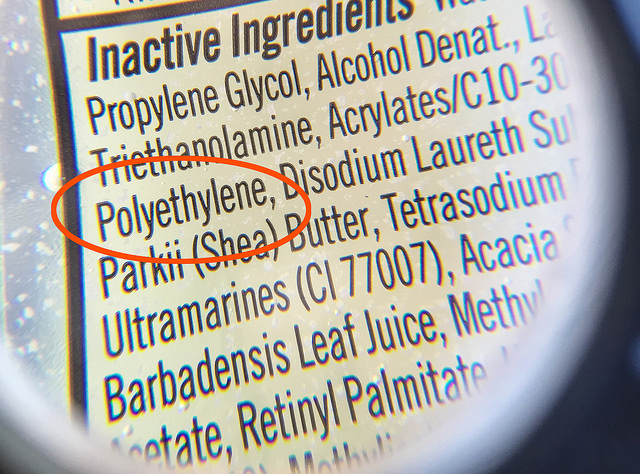本月稍早,美國「無柔珠水域法」(Microbead-Free Waters Act)在參眾兩院獲無異議通過,29日更在總統歐巴馬的簽署之下,正式立法。2017年7月1日起不得再生產含有塑膠柔珠的洗面乳、牙膏和洗髮精,2018年7月1日起全面禁止銷售。
塑膠微珠的大小比針頭還小,肉眼幾乎看不見。圖片來源:MN Pollution Control Agency(CC BY-NC 2.0)。
吸附毒質回到人體 美國出現柔珠危機
柔珠是個人清潔用品中常見的磨砂用塑膠微珠,尺寸比針頭還小,肉眼幾乎看不見。但也由於尺寸太小,進入下水道系統後,無法被廢水處理廠過濾,往往污染湖泊、河川和海洋。
柔珠最常見的成分是聚乙烯、聚甲基丙烯酸甲酯、尼龍聚對苯二甲酸乙酯和聚丙烯。一管磨砂洗面乳可能含有超過35萬顆柔珠。每年進入美國下水道系統的柔珠高達2.9兆顆。
學界已知柔珠會吸收污染物,且經常被魚類和野生動物誤食。柔珠一旦進入環境,表面便開始附著殺蟲劑、阻燃劑等有毒物質,經過攝食進入魚的組織。一份近期的研究發現,加州市場販售的魚中,有1/4攝食過塑膠柔珠。
伊利湖和安大略湖是美國柔珠含量最高的水域。紐約州立大學一份研究發現,伊利湖平均每平方公里的湖水就有4萬6000顆柔珠,遠高於蘇必略湖的6000顆,休倫湖的8000顆和密西根湖的1萬7000顆。
個人美保產品禁用柔珠 可分解塑膠做的也不行
繼今年稍早加州宣布禁用柔珠後,「無柔珠水域法」也禁止所有個人美保產品使用柔珠,包括可分解塑膠製成的柔珠,因為這些所謂可分解塑膠大部份在海裡其實無法分解。
此立法獲得個人保養產品理事會、大湖聯盟、美國化學理事會、露華濃、寶潔、嬌生、塑料工業貿易協會和消費者保健產品協會等組織的支持。
化學公司W.R. Grace & Co.已經開始生產可取代塑膠柔珠的合成矽膠微粒。該公司指出,這種合成矽膠微粒不具生物累積效應和生物持續性,且經過處理後能有很好的磨砂效果。
其他替代品包括生技公司TerraVerdae BioWorks推出的可生物分解天然微粒,可直接取代個人清潔與化妝品中的塑膠柔珠。
在法令生效前,避免使用柔珠產品並不困難。只要確認產品中不含聚乙烯和聚丙烯即可。
避免使用柔珠產品並不困難。只要確認產品中不含聚乙烯(polyethylene)和聚丙烯(polypropylene)即可。圖片來源:MN Pollution Control Agency(CC BY-NC 2.0)。
President Barack Obama Monday signed into law a bill phasing out the manufacture of facewash, toothpaste and shampoo containing plastic microbeads by July 1, 2017 and the sale of these products by July 1, 2018.
The Microbead-Free Waters Act (H.R. 1321) was unanimously approved by both chambers earlier this month.
Microbeads are minuscule scrubbers found in cleansers, body scrubs, and toothpaste. On their own, they are nearly invisible, smaller than a pinhead. But once they go down the drain, problems begin.
Plastic microbeads, designed to be washed down the drain and too small to be reliably captured by wastewater treatment facilities, pollute lakes, rivers and oceans. One tube of exfoliating facewash can contain more than 350,000 microbeads. Some 2.9 trillion microbeads are estimated to enter U.S. waterways annually.
The types of plastic most commonly used as microbeads are: polyethylene, polymethyl methacrylate, nylon polyethylene terephthalate and polypropylene.
Microbeads are known to absorb pollutants and are often mistaken as food by fish and wildlife.
Once in the environment, plastic microbeads concentrate toxins such as pesticides and flame retardants on their surfaces. These toxic substances may then transfer to the tissue of fish that mistake microbeads for food. A recent study found that one-quarter of fish purchased at California markets had ingested plastic.
Lakes Erie and Ontario have the highest concentrations of microbeads of any U.S. waters. A report by scientists from the State University of New York found Lake Erie averaged about 46,000 particles of plastic per square kilometer, compared to about 6,000 to 8,000 particles over the same area in lakes Superior and Huron and about 17,000 particles in Lake Michigan.
Following California’s landmark microbead ban enacted earlier this year, the Microbead-Free Waters Act bans all plastic microbeads from beauty products, including those made from so-called “biodegradable plastics,” as most of them do not biodegrade in marine environments.
This legislation is supported by the Personal Care Products Council, the Alliance for Great Lakes, the American Chemistry Council, Revlon, Proctor & Gamble, Johnson & Johnson, the Plastics Industry Trade Association and the Consumer Healthcare Products Association.
W.R. Grace & Co. already is offering an alternative made with odorless, tasteless, and chemically inert synthetic micronized silica. “Grace exfoliating silica gels do not bioaccumulate, are not biopersistent, and can be engineered to provide exceptional exfoliating properties,” the company said in a statement.
Other alternatives are also in the works. In June, TerraVerdae BioWorks, an industrial biotechnology company headquartered in Canada with operations in the United States and the UK, announced a line of biodegradable, natural microspheres for use in personal care and cosmetic products, as a direct replacement for plastic microbeads that are the subject of restrictive legislation.
Until the ban takes effect, avoiding products with microbeads is not difficult. Check ingredient labels for polyethylene and polypropylene.
※ 全文及圖片詳見:ENS






